In an era where digital ecosystems thrive on seamless connectivity, APIs serve as the backbone of modern software, facilitating interactions across countless applications and services. Yet, with this reliance comes a staggering challenge: ensuring these APIs function flawlessly under diverse conditions. Industry reports suggest that over 80% of software failures stem from API-related issues, underscoring the critical need for robust testing tools. Enter Postman, a platform that has emerged as a cornerstone for API testing, empowering developers and testers to validate, debug, and optimize their integrations with unparalleled precision. This review dives deep into Postman’s capabilities, exploring how it addresses the pressing demands of API reliability in today’s fast-paced development landscape.
Understanding the Role of Postman in API Testing
Postman stands as a pivotal tool in the realm of API development and testing, offering a comprehensive environment to design, execute, and analyze API interactions. Its intuitive interface simplifies the process of crafting requests and inspecting responses, making it accessible to both seasoned developers and newcomers. The platform’s significance lies in its ability to bridge the gap between complex API architectures and the need for straightforward validation, ensuring that software components communicate effectively.
Beyond ease of use, Postman integrates seamlessly with agile methodologies, supporting rapid iterations in development cycles. Its compatibility with modern workflows, such as DevOps practices, positions it as an essential asset for teams aiming to maintain high software quality. This adaptability has cemented Postman’s reputation as a go-to solution for organizations navigating the intricacies of API-driven systems.
Key Features Driving Postman’s Effectiveness
Building and Executing API Requests
At the heart of Postman’s functionality is its robust system for constructing and sending HTTP requests. Testers can easily define various methods, customize headers, and attach payloads to simulate real-world API interactions. This flexibility allows for quick validation of responses, ensuring that endpoints behave as expected under different scenarios.
The platform excels in handling intricate request structures, which proves invaluable when dealing with nested data or multipart forms. Its performance in executing these requests swiftly enhances productivity, reducing the time spent on manual testing. Such capabilities make Postman a reliable choice for validating API functionality with precision and speed.
Automation through Scripts and Assertions
Postman’s automation features elevate its utility by enabling testers to write JavaScript-based pre-request and test scripts. These scripts facilitate automated validation of API responses through assertions, ensuring consistency in expected outcomes. This reduces human error and streamlines repetitive tasks, a critical advantage in high-frequency testing environments.
Integration with continuous integration and continuous deployment (CI/CD) pipelines further amplifies the value of Postman’s automation. Teams can embed automated test suites into their deployment processes, catching issues before they reach production. This level of efficiency underscores Postman’s role in maintaining software integrity across iterative releases.
Emerging Innovations and Industry Trends
Postman continues to evolve with cutting-edge advancements, notably through AI-powered features like Postbot, which assists in test creation and debugging. This innovation minimizes manual effort by suggesting fixes and generating test scripts, aligning with the industry’s push for smarter, faster testing solutions. Such tools reflect a broader trend toward leveraging artificial intelligence to enhance development workflows.
Collaboration also takes center stage with Postman’s shared workspaces, enabling teams to work cohesively on API projects. Coupled with growing integration capabilities with CI/CD tools, the platform adapts to the industry’s shift toward quicker release cycles and API-first development approaches. These trends highlight Postman’s commitment to staying ahead of technological demands.
Practical Applications Across Diverse Sectors
Postman’s real-world impact spans multiple industries, from e-commerce to fintech and healthcare, where API reliability is paramount. In payment gateway systems, for instance, Postman ensures secure and accurate transaction processing by rigorously testing endpoints for edge cases. This reliability is crucial for maintaining trust in critical financial operations.
Unique scenarios, such as debugging third-party API integrations, showcase Postman’s versatility. It enables teams to pinpoint discrepancies in microservices architectures, ensuring smooth interoperability between disparate systems. These applications demonstrate how Postman addresses niche challenges while delivering consistent value across varied contexts.
Navigating Challenges and Limitations
Despite its strengths, Postman is not without hurdles, particularly the risk of over-reliance on automated features like Postbot’s test-fixing suggestions. Such tools may adjust assertions to make tests pass without addressing underlying flaws, potentially masking significant bugs. This automation bias poses a challenge to maintaining true software quality.
Technical limitations also surface when managing large-scale test suites or handling environment-specific inconsistencies. New users might face a learning curve, compounded by occasional gaps in documentation. However, ongoing improvements in community support and resources aim to mitigate these barriers, fostering a more accessible user experience.
Looking Ahead: The Future of Postman
Postman’s trajectory points toward deeper enhancements in AI-driven testing, promising even more intelligent automation capabilities. Potential expansions in support for emerging API protocols and tighter integrations with DevOps ecosystems signal a forward-thinking approach. These developments could redefine how teams approach API validation in increasingly complex systems.
The long-term influence of Postman on software quality assurance appears substantial, especially as API-centric architectures dominate. Its adaptability to cultural and technological shifts suggests a lasting impact on testing practices. Keeping pace with these changes will likely solidify Postman’s position as an indispensable tool in the years ahead, from 2025 to 2027 and beyond.
Final Reflections and Recommendations
Looking back, this exploration of Postman revealed a tool that stands as a powerful ally in the quest for API reliability, blending user-friendly design with robust automation. Its performance in real-world applications, from securing financial transactions to debugging intricate integrations, proves its worth across diverse domains. Challenges like automation bias and scalability issues emerge as notable considerations, yet do not overshadow its overall effectiveness.
For teams and developers moving forward, the next step involves adopting a balanced approach to Postman’s features, leveraging automation while prioritizing root-cause analysis over quick fixes. Investing in training to navigate its learning curve and contributing to community-driven documentation efforts could enhance its accessibility. As API ecosystems continue to grow, positioning Postman as a central component of testing strategies offers a proactive path to ensuring software excellence.









